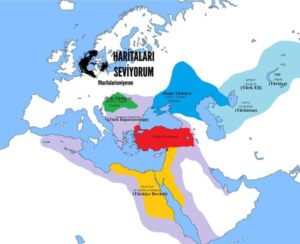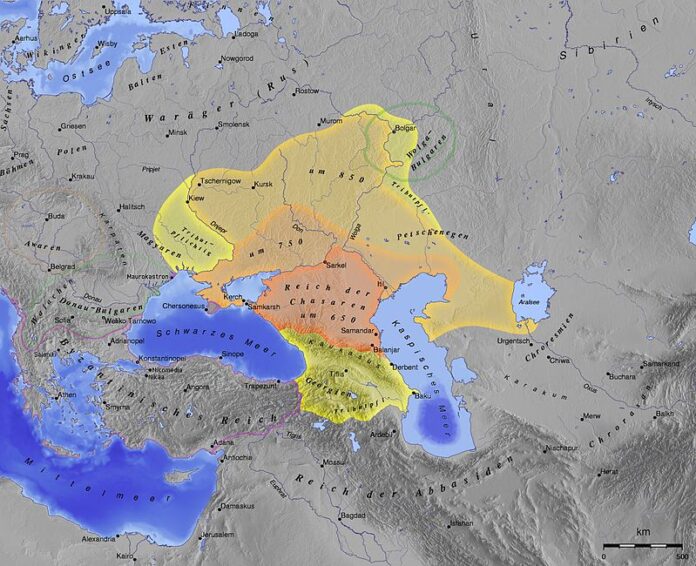Map: Khazar Khaganate, 650–850
Byzantine sources refer to Hungary as Western Tourkia in contrast to Khazaria, Eastern Tourkia.
The Byzantines called Khazaria Tourkía, and by the 9th century referred to the Khazars as “Turks”
The Khazars[a] (/ˈxɑːzɑːrz/) were a semi-nomadic Turkic people that in the late 6th-century AD established a major commercial empire covering the southeastern section of modern European Russia, southern Ukraine, Crimea, and Kazakhstan.[10] They created what for its duration was the most powerful polity to emerge from the break-up of the Western Turkic Khaganate.[11] Astride a major artery of commerce between Eastern Europe and Southwestern Asia, Khazaria became one of the foremost trading empires of the early medieval world, commanding the western marches of the Silk Road and playing a key commercial role as a crossroad between China, the Middle East and Kievan Rus’.[12][13] For some three centuries (c. 650–965) the Khazars dominated the vast area extending from the Volga-Don steppes to the eastern Crimea and the northern Caucasus.[14]
- Tourkia (Khazaria) (“eastern Tourkia”), designation for the early medieval Khazar state in Byzantine sources
- Tourkia (Hungary) (“western Tourkia”), designation for the medieval Hungarian state in Byzantine sources
The Byzantine Constantine Porphyrogennetos called Árpád “ho megas Tourkias archon” (the great prince of Tourkia),[52] and all of the 10th-century princes who ruled the country held this title.[5] Peter B. Golden, Nomads and their neighbours in the Russian steppe: Turks, Khazars and Qipchaqs, Ashgate/Variorum, 2003.
“Tenth-century Byzantine sources, speaking in cultural more than ethnic terms, acknowledged a wide zone of diffusion by referring to the Khazar lands as ‘Eastern Tourkia’ and Hungary as ‘Western Tourkia.‘” Carter Vaughn Findley, The Turks in the World History Archived 5 February 2016 at the Wayback Machine, Oxford University Press, 2005, p. 51, citing Peter B. Golden, ‘Imperial Ideology and the Sources of Political Unity Amongst the Pre-Činggisid Nomads of Western Eurasia,’ Archivum Eurasiae Medii Aevi 2 (1982), 37–76.























